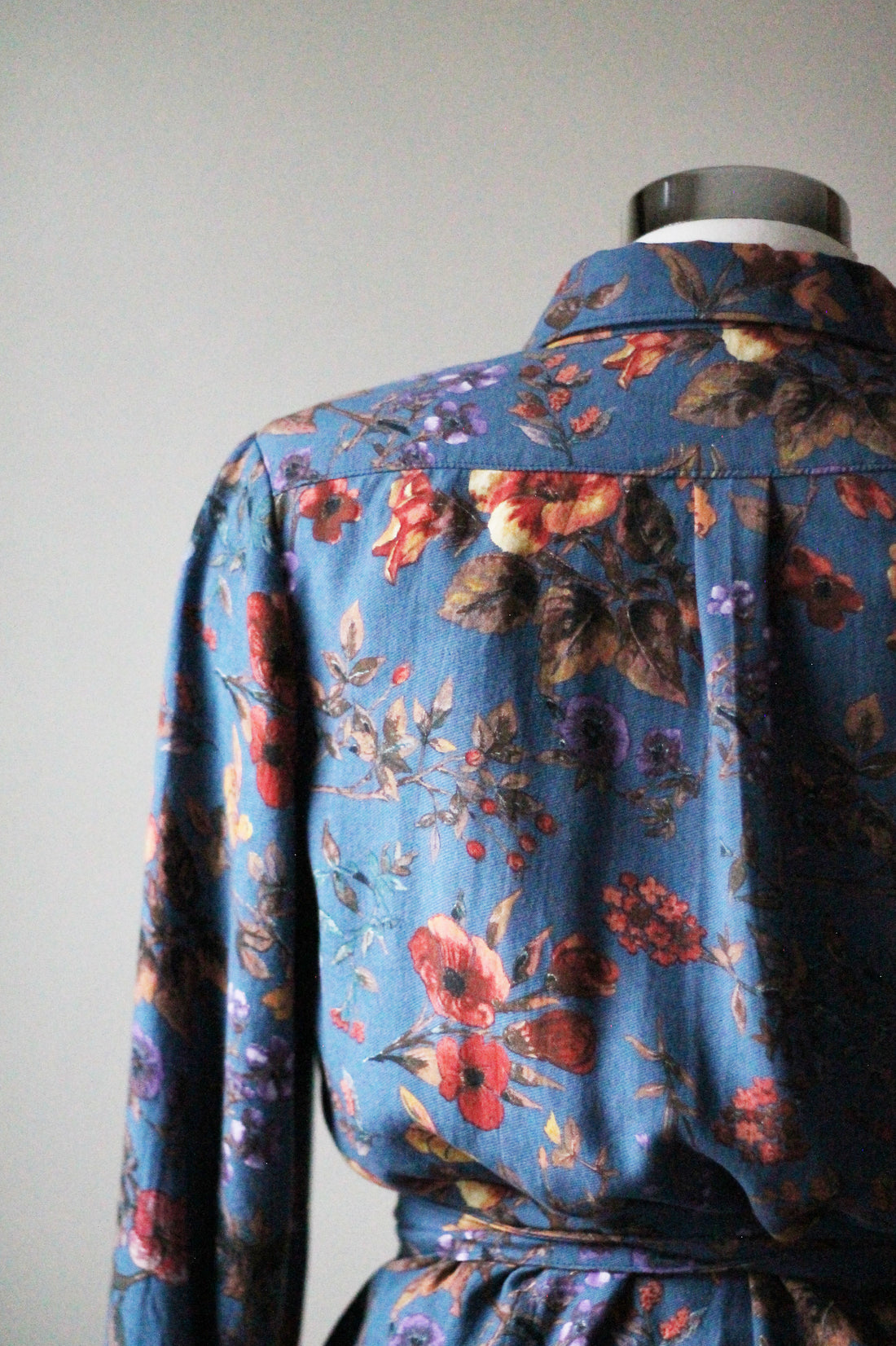
Shirtmaking: Adding a Yoke to a Blouse Pattern (Burrito Method)
When I was designing the Byrdie Button-up, I waffled back and forth on whether or not to add a yoke to the pattern. The original inspiration for this shirt was a sheer blouse with tucks that did not have a yoke, so my mind was in blouse-mode and not traditional button-up shirt mode in the beginning.
The pattern evolved as I started designing the options for each version and the collared shirt was added, and since I like to make my patterns versatile and hackable, I decided to leave out the yoke to have flexibility for hacking tutorials.
I used the book Shirtmaking: Developing Skills for Fine Sewing, by David Page Coffin, as a frequent resource while working on the Byrdie pattern samples. It is loaded with great information on constructing beautiful shirts and I highly recommend it (I checked it out from my local library and ended up buying a copy since I was referring to it so much and had exceeded my renewals!). Coffin talks a lot about the purpose and construction of each part of a shirt, including the yoke. I really enjoyed his teaching style and general ethos of trying new things and experimenting with techniques to find what works for your personal sewing practice. I did, indeed, develop several new skills using this book and will be covering a few in the Byrdie Sewalong and other shirtmaking posts on this blog.
So here we are!


Adding a yoke is super easy.
We’ll be chopping off the shoulder portion of the front and back bodice pattern pieces of the Byrdie Button-up pattern and combining them to create the yoke (but you can do this for pretty much ANY blouse or shirt pattern). Then we’ll use the “burrito” method to put it all together.
What is the purpose of a yoke?
Traditionally, the yoke serves to provide support for shirt fabric around the shoulder and upper back for men’s shirts, and allows the fabric at the shoulder to lay comfortably under a suit jacket, shifting the seam off the top of the shoulder. The seam only needs to be shifted a couple of inches off of the shoulder in the front and back.
A yoke is also a way to add shaping to a shirt, primarily in the back bodice. It’s basically a big ol’ dart system if you choose to use it that way, which can be employed to shape a shirt around the curves of the upper back. It can also be used for shaping at the front bodice.
A lot of modern shirts have much larger yokes with generous ease, especially in womenswear. The larger yoke is usually a style decision and not necessarily a function of better fit or comfort.
I’ve also read that the addition of a yoke breaks up the pattern pieces, allowing for greater fabric efficiency, which seems to make sense (but really only if you are using one yoke piece instead of two). Smaller pattern pieces provide more opportunity for color blocking and scrap busting as well, and I like that!
A quick note on yoke sizing…
If you want to do a larger yoke on the Byrdie Button-up, you might want to consider doing a broad back adjustment and/or broad shoulder adjustment, or even sizing up. Extending the yoke further down the back bodice—more than a couple of inches—will make the upper back more rigid and may make it feel tighter across the back. The back pleat beneath the yoke gives a little extra ease for stretching the arms forward, so shifting it too far down from the broadest part of the back will make the back pleat ineffective.
Ok, let’s get to it!
Design your yoke by modifying the existing bodice pattern pieces
Start by outlining the shoulder of both the front and back bodice pattern pieces (use Version A if using the Byrdie Button-up pattern) on a new sheet of paper. You only need to get the top few inches of the pattern outlined. These will make up the yoke pattern piece.

Trace around the perimeter of the pattern.

Front Bodice

Back Bodice
Mark the seam allowance at the shoulder for the back yoke. Then mark 2” down from the outer shoulder seam for the back yoke piece. As you draw the line at 2”, make sure you are keeping your line at a 90 degree angle, squared, to the center back.


Then add a 5/8” seam allowance to the bottom of the back yoke pattern piece.

Do the same steps for the front yoke piece, but only add an inch for the front yoke (plus seam allowances on top and bottom) as shown below. The lines on the front yoke piece should be parallel to the shoulder line. I’ve labeled the shoulder seams and yoke seams to help me keep everything straight. Cut out the yoke pattern pieces.

Lay the yoke piece on top of the corresponding bodice piece aligned with the shoulder and mark the yoke seam and seam allowance 5/8” above it on the bodice pattern piece.


Do the same for the shoulder of the front bodice.


After marking the bodice pattern pieces, either cut or fold the pattern at the seam allowance line (I folded mine under to preserve the original pattern piece):


Now combine the front and back yoke pattern pieces you created, overlapping them at the “Shoulder Seam” lines.


And don’t forget to trim the center back of the yoke to eliminate the back pleat (or back tucks, if sewing Version B). The center back of the bodice is marked on the pattern piece, 1” in from the “Cut on fold” line. The back pleat will remain on the back bodice piece, just not on the yoke..

Annotate the yoke pattern piece and you are ready to cut fabric!

Cut and prep the pattern pieces
Cut two yoke pieces on the fold from your fabric. It’s also a good idea to clip notches at the center back at the neckline and bottom edge of the yoke. I also forgot to clip the original shoulder seam location for aligning the sleeve later, so be sure to do that too!

Cut your bodice pieces. If sewing a button placket and bust darts, it’s a good idea to go ahead and do those before attaching the yoke. You’ll also want to go ahead and baste the back pleat in place (in the pattern instructions for the Byrdie, it is instructed to sew the back pleat at the center to about 3” or 4” down from the neckline. You only need to baste the top of the pleat when adding the yoke).

Back bodice pleat, basted at the top.
Attach the yoke to the back bodice
Lay the back bodice face up and align one of the yoke pieces face down on top along the yoke seam. Sew the pieces together at the yoke seam with a 1/4” seam allowance.

Flip the bodice/yoke over so that the bodice is face down and align the other yoke piece face down on top along the yoke seam. The bodice will be sandwiched between the two yokes. Sew all three pieces together along the yoke seam with a 5/8” seam allowance.

Grade the yoke seam allowance to about 1/8” to 1/4”.

Press both sides of the yoke away from the bodice and topstitch the yoke seam.

Attach the yoke to the front bodice
Lay the back bodice with the yoke attached face down and flip the exterior yoke out of the way underneath.

Lay the front bodice pieces face up on top, aligning the front yoke/shoulder seams (you’re only attaching them to the interior side of the yoke). Sew the seams with a 1/4” seam allowance.

The burrito method
Roll the bodice tightly all the way up to the yoke so that you can see the shoulders of each yoke piece, mirrored top and bottom as shown below.

Now fold the bottom yoke piece over the rolled up bodice and align the shoulder seams right sides together. If it feels like the bodice will be in the way, unroll it and re-roll it as tight as you can so that you can pin the shoulder seams together evenly and have enough room for the 5/8” seam allowance.

Sew the shoulder seams with a 5/8” seam allowance, careful not to sew through the rolled up bodice.

Grade the seams to 1/8” to 1/4”. Then pull the rolled up bodice through the neck opening of the yoke until it’s completely unrolled and the yoke is flat.



Here’s how it looks from the exterior side.

Here’s a (blurry, sorry!) shot of the interior side.
Once everything is pulled through, press and topstitch the yoke seams, and staystitch the armscyes and neck opening.

And that’s how you add a yoke! Now you can continue the construction of the garment as originally instructed for the remaining steps.
Here’s how it all looks once the garment (a Byrdie Button-up Version A Dress, in this case) looks when the yoke is all finished.



